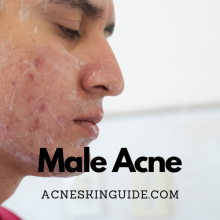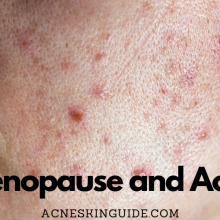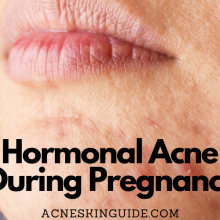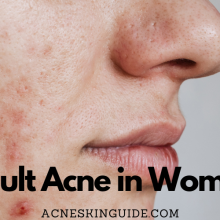Baby Acne | Acne Skin Guide
Baby acne, or infantile/neonatal acne, is a harmless and common condition that causes small red pimples, whiteheads, or bumps on a newborn’s skin, usually on the face, neck, back, or chest. It’s primarily caused by hormonal changes from the mother that overstimulate the baby’s oil glands. Other triggers include friction, trapped sweat, genetics, and certain ingredients in breast milk or formula. Baby acne typically appears 2-4 weeks after birth and resolves within a few months, though some cases persist longer.
Most cases don’t require treatment, just gentle cleansing and avoiding harsh products. Home remedies like breast milk or oils can help soothe irritation. Prevention involves keeping the area clean, using mild products, and avoiding tight clothing. While usually harmless, severe or persistent cases, or those with additional symptoms like fever, warrant medical attention to rule out other conditions. With proper care and patience, baby acne clears up without long-term effects.
#1 Recommended Acne Treatment | #2 Recommended Acne Treatment |
 |  |

Navigating Baby Acne: What Every Parent Needs to Know
Bringing a new baby into the world is an incredibly exciting and joyful experience, but it can also come with its fair share of worries and concerns. One common issue that many new parents face is the appearance of pimples or red bumps on their newborn’s skin, known as baby acne. While it may look alarming at first, understanding what baby acne is, its causes, and when to seek medical attention can help ease any anxieties.
What is Baby Acne?
Baby acne, also known as infantile or neonatal acne, is a harmless condition that causes small red pimples, whiteheads, or tiny bumps to appear on a newborn’s skin. Unlike other rashes, baby acne is characterized by distinct, individual bumps or “pimples.” It most commonly affects the face, but can also show up on the neck, back, and chest areas.
Causes of Baby Acne
The primary cause of baby acne is believed to be hormonal changes. During pregnancy, hormones from the mother are passed to the baby, which can overstimulate the baby’s oil glands, leading to the development of acne. Other potential triggers for baby acne include friction from rough fabrics, trapped sweat or moisture, genetics, and certain ingredients in breast milk or formula that may cause a reaction.
When Does It Appear and How Long Does It Last?
Baby acne typically first appears around 2 to 4 weeks after birth, though it can sometimes occur earlier or later. For most babies, the acne resolves within a few months, usually clearing up by the time the baby is around 4 to 6 months old. However, in some cases, baby acne can persist for longer periods.
Home Care and Treatment
In the majority of cases, baby acne does not require any specific treatment, as it will clear up on its own over time. Home care for baby acne involves gentle cleansing with mild, fragrance-free baby washes or wipes, and avoiding harsh scrubs or products that could further irritate the skin. Some over-the-counter creams or ointments containing ingredients like hydrocortisone or benzoyl peroxide may help alleviate the symptoms, but it’s always best to consult with a pediatrician before using any topical treatments on a newborn.
Home remedies, such as applying a thin layer of breast milk or natural oils like coconut or olive oil, can also be effective in soothing and moisturizing the affected areas. However, it’s important to avoid popping or squeezing the pimples, as this can lead to further irritation and potential scarring.
Prevention Tips
While baby acne is often unavoidable, there are certain steps parents can take to help prevent or minimize its occurrence. Keeping the baby’s face clean by gently wiping it with a soft, damp cloth or using mild, fragrance-free wipes is essential. It’s also important to use only mild, gentle products specifically formulated for babies, as harsh chemicals or fragrances can further irritate the skin.
Avoiding tight clothing that causes friction or traps sweat against the skin can also help prevent baby acne. Additionally, always washing your hands before touching your baby’s face can help prevent the transfer of oils or bacteria that could potentially clog pores and exacerbate the condition.
When to See a Doctor
While baby acne is generally harmless and temporary, there are certain situations when it’s advisable to seek medical attention. If the acne becomes severe or widespread, covering large areas of the body, it’s best to consult with a pediatrician or dermatologist. Similarly, if the acne is accompanied by other symptoms such as fever, redness, or swelling, it could be a sign of a more serious condition that requires medical evaluation.
If the acne persists beyond the expected timeframe of a few months or shows no signs of improvement, it’s also recommended to seek professional guidance. In some cases, what may initially appear to be baby acne could actually be another skin condition, such as eczema, cradle cap, or heat rash, which may require different treatment approaches.
Emotional Impact and Reassurance
Having a newborn with bumps or pimples on their skin can understandably cause anxiety and concern for new parents. It’s important to remember that baby acne is extremely common and temporary, affecting up to 20% of newborns. With proper care and a little patience, it will resolve without any long-term effects on the baby’s skin.
While baby acne may not be aesthetically pleasing, it is a harmless and typical part of infant development for many newborns. By understanding what it is, its causes, and when to seek medical attention, parents can navigate this phase with confidence and focus on enjoying the precious moments with their new bundle of joy.
Downsides:
While baby acne is generally considered harmless and temporary, there are a few potential downsides or concerns to be aware of:
- Emotional distress: Although it’s a common condition, the appearance of pimples or bumps on a newborn’s skin can cause significant emotional distress and anxiety for new parents. It’s essential to provide reassurance and education to help alleviate these concerns.
- Risk of scarring: While rare, there is a small risk of scarring if baby acne is not properly cared for or if the pimples are picked or popped. Avoiding any aggressive treatment or manipulation of the bumps is crucial to prevent scarring.
- Potential for secondary infections: In severe cases or if the acne is not properly managed, there is a risk of secondary bacterial infections, which can lead to more serious complications. Seeking medical attention if the acne becomes severe or is accompanied by other symptoms is essential.
- Misdiagnosis: In some cases, what may initially appear to be baby acne could be a different skin condition, such as eczema or cradle cap, which may require different treatment approaches. Proper diagnosis and management are important to ensure the correct treatment is provided.
- Persistence: While baby acne typically resolves within a few months, in some cases, it can persist for longer periods, leading to ongoing concerns and frustration for parents.
Overall, while baby acne is generally a harmless and temporary condition, it’s important to be aware of these potential downsides and to seek professional medical advice if any concerns arise or if the acne persists beyond the expected timeframe.
#1 Recommended Acne Treatment | #2 Recommended Acne Treatment |
 |  |
Summary and FAQs
Can baby acne be caused by a breastfeeding mother’s diet?
Yes, a breastfeeding mother’s diet can potentially contribute to or cause baby acne in some cases. Here are a few ways a mother’s diet may play a role:
- Dairy products: Proteins from cow’s milk products like cheese, yogurt, and milk itself can sometimes lead to inflammation and clogged pores in babies. This is because the proteins can pass through breastmilk and trigger an adverse reaction.
- Spicy/acidic foods: Eating very spicy, acidic, or “heating” foods may cause changes in the composition of breastmilk that could irritate a baby’s sensitive skin and exacerbate acne.
- Food sensitivities: If a breastfed baby is sensitive or allergic to certain foods in the mother’s diet, it can manifest as skin issues like acne. Common culprits include dairy, soy, wheat, eggs, and nuts.
- Hormones in foods: Some foods like soy products contain plant estrogens that could potentially disrupt a baby’s hormonal balance and contribute to acne flare-ups.
However, it’s important to note that every baby and every mother’s diet is different. Breastfeeding is still recommended, and cutting out major food groups is usually not advised unless there is a clear established food sensitivity. Working with a lactation consultant can help identify potential dietary triggers.
Is it safe to use over-the-counter acne treatments on my baby?
It is generally not recommended to use over-the-counter (OTC) acne treatments on babies, as their skin is extremely delicate and sensitive. Most OTC acne products contain ingredients that can be too harsh or drying for a baby’s skin.
Some key points about using OTC acne treatments on babies:
- Benzoyl peroxide: This common acne treatment ingredient can cause excessive dryness, peeling, redness, and irritation on a baby’s sensitive skin.
- Salicylic acid: Products with salicylic acid should be avoided as it can be absorbed into a baby’s bloodstream and potentially cause issues.
- Retinoids: Retinoid creams like adapalene or retinol are too strong for infant skin and may cause rashes, peeling, or increased sun sensitivity.
- Adult acne cleansers: Face washes marketed for adult acne often contain drying ingredients like alcohol or sulfates that strip away protective oils.
Instead of OTC treatments, it’s recommended to:
- Use very gentle, fragrance-free cleansers and moisturizers specifically formulated for babies
- Try natural home remedies like breast milk or noncomedogenic oils if needed
- Consult your pediatrician if concerned, as they may prescribe a mild hydrocortisone cream in severe cases
The risks of OTC acne products often outweigh any potential benefits for treating baby acne. It’s best to let it resolve naturally while keeping the area clean and avoiding harsh products until it clears up.
Can baby acne be a sign of an underlying medical condition?
In the vast majority of cases, baby acne is not a sign of an underlying medical condition. It is an extremely common, harmless condition caused primarily by exposure to maternal hormones before birth.
However, there are a few rare instances where baby acne could potentially be a symptom of another issue:
- Congenital adrenal hyperplasia
This is a rare inherited disorder that causes excessive production of androgens (male hormones). Baby acne that is particularly severe or accompanied by other symptoms like rapid weight gain may indicate this condition. - Other endocrine disorders
Hormonal imbalances from conditions affecting the pituitary, thyroid or other endocrine glands could theoretically contribute to abnormal acne in infants, though this is very uncommon. - Allergic reactions
In some cases, persistent baby acne that does not resolve could potentially be an allergic reaction to a food product passed through breastmilk, formula ingredients, or something in the baby’s environment. - Infection
Acne lesions that become extremely inflamed, draining pus, or accompanied by fever could potentially indicate a secondary bacterial skin infection requiring medical treatment.
For the overwhelming majority of babies, however, the appearance of typical newborn “pimples” is completely normal and no cause for concern about an underlying condition. But persistent, severe or unusual cases merit having it evaluated by the pediatrician to rule out any other issues. Otherwise, harmless baby acne will resolve on its own within a few months.
Are there any long-term effects of baby acne on skin health or development?
No, there are typically no long-term effects of baby acne on skin health or development. Baby acne is a very common, temporary condition that resolves on its own without causing any lasting issues.
Here are some key points about the lack of long-term impacts from baby acne:
Skin Health:
- Baby acne does not permanently damage or scar the skin when properly cared for by avoiding picking/squeezing the bumps.
- It does not lead to future severe acne problems in childhood or adulthood.
- Once the acne clears up around 4-6 months, the baby’s skin returns to its normal, healthy state.
Physical Development:
- Baby acne is purely a cosmetic condition that does not affect the baby’s physical growth and development in any way.
- It does not cause or contribute to any delays in reaching typical developmental milestones.
Psychological Effects:
- While baby acne may cause some temporary parental anxiety, research shows it does not lead to any lasting psychological impacts on babies.
- It resolves before babies even become self-aware enough to be impacted psychologically.
The only potential long-term effect would be residual darkening/marks on the skin if acne was severe and not properly cared for. But with gentle, appropriate treatment, these marks also typically fade over time.
Overall, baby acne is considered a harmless, short-lived condition with no long-lasting consequences for skin or overall infant health and development. Its transient nature means it clears up without any future effects once it runs its course.
How can I prevent baby acne from leaving marks or discoloration?
Here are some tips to help prevent baby acne from leaving behind marks or discoloration on your baby’s skin:
- Avoid picking, squeezing, or popping the pimples/bumps. This can increase inflammation and make marks more likely to develop and last longer.
- Use gentle cleansing. Wash the affected areas with a mild, fragrance-free cleanser and warm water once a day. Avoid harsh scrubbing.
- Apply sunscreen. Use a mineral-based sunscreen made for babies on any exposed pimples when going outside, as sun exposure can darken marks.
- Try natural remedies. Applying a thin layer of breast milk or non-comedogenic oils like coconut oil can soothe irritation and promote healing.
- Moisturize regularly. Keep the area hydrated with a gentle, hypoallergenic moisturizer to promote faster healing.
- Be patient. While active pimples are present, marks may look darker. But with time, these will start to fade once the acne clears up.
- Consider medical treatment. For severe or persistent cases, your pediatrician may prescribe a mild hydrocortisone cream to reduce inflammation and discoloration.
- Avoid scrubbing or irritating the skin. Don’t use rough washcloths or towels that could further irritate and inflame the bumps.
With proper gentle care and time, most mild redness or darkened marks from baby acne will fade within a few weeks to months after the breakouts resolve. See a dermatologist if discoloration persists long-term.






